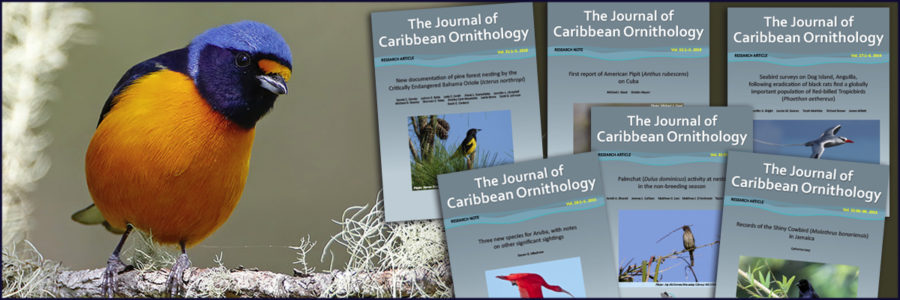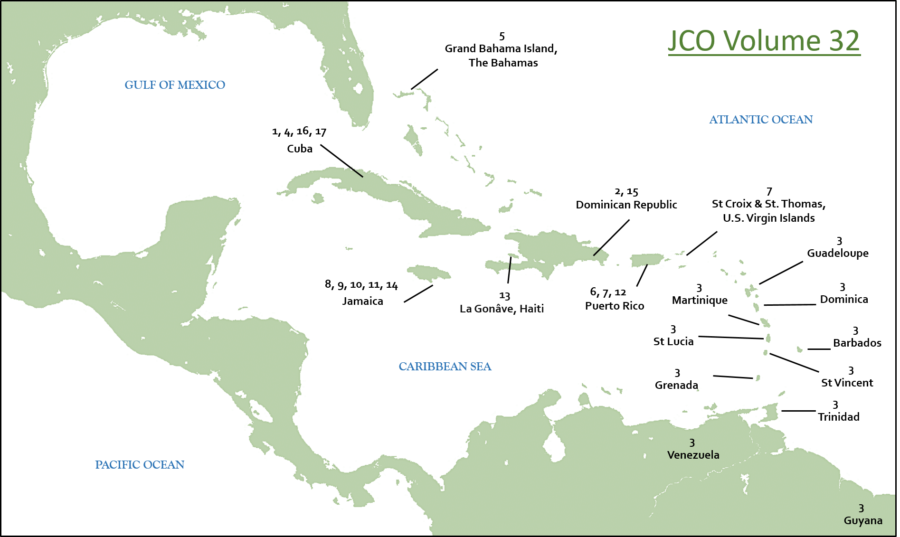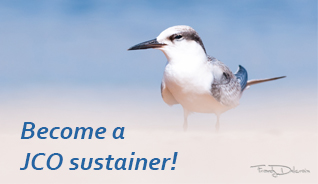
From all of us at JCO, thank you to all of the authors and reviewers that contributed to a very successful Volume 32!
Inside you’ll find a sizable number of publications, including 16 research articles, our first designated “Conservation Report,” 4 book reviews, Recent Ornithological Literature from the Caribbean, and a special In Memoriam for the late Dr. James. W. Wiley.
I want to give some much-earned recognition to the 2019–2020 JCO team. While they were undertaking the aforementioned load of manuscripts, they were working double-time to make some incredible improvements behind-the-scenes. Let me just say that it’s no easy task to create and adopt a new workflow while you simultaneously have a dozen manuscripts—each at different stages— moving through the old workflow. And this new workflow means better communication, a higher-caliber final product, and a more efficient pathway for a manuscript to proceed from submission to publication. All great things!
Please take some time to enjoy all of Volume 32. Inside you’ll find a suite of excellent work stemming from more than 17 countries across the Caribbean. We should all take pride in this work and make the time to congratulate each other on all of these accomplishments. If you enjoyed reading a publication, please send the authors a quick email letting them know. That is what makes Caribbean ornithology special—a sense of community and comradery unlike anywhere else.
Thank you for your support of JCO!
— Justin Proctor, JCO Managing Editor

RESEARCH ARTICLES AND NOTES
Michael J. Good and Giraldo Alayon
On December 3rd, 2014, ornithologists spotted an American Pipet during an annual Cuba Bird Survey led by the Caribbean Conservation Trust. Previously undocumented in Cuba, this observation marks the first report of this species on the island, and underscores the importance of the Guanahacabibes region as an important stopover for fall migrants.
James F. Dwyer, Thomas I. Hayes, Russell Thorstrom, and Richard E. Harness
After a translocation program for the Critically Endangered Ridgway’s Hawk was stymied by electrocutions in the Dominican Republic, Dwyer et al. began to investigate. In this article, the authors identify the errors made while retrofitting power poles and discuss the necessity of properly mitigating electrocution risks for this project, and others throughout the Caribbean.
Meghann B. Humphries, Maribel A. Gonzalez, and Robert E. Ricklefs
Currently, there are eight subspecies of Carib Grackle distributed across the Lesser Antilles and northern South America. By sequencing mitochondrial genes of Carib Grackles across their range, Meghann et al. shed light on the phylogenetic and geographic history of the species, bringing into question the bases for the subspecies classifications.
Martín Acosta and Lourdes Mugica
In response to the dearth of current literature on the White-crowned Pigeon, Acosta and Mugica compiled the latest data on this Vulnerable species in Cuba. Here, they present their findings, focusing on the current distribution of the species as well as conservation measures that have contributed to the perseverance of the species.
Anthony Levesque, Antoine Chabrolle, Frantz Delcroix, and Eric Delcroix
While the Sedge Wren commonly winters in Florida, it has yet to be recorded in the Caribbean, until now. In this article, Levesque et al. recount their sighting of this species on Grand Bahama Island, providing descriptions and photographs of the bird’s diagnostic features and the habitat where it was located.
Christopher C. Rimmer, John D. Lloyd, and Jose A. Salguero-Faria
After Puerto Rico was identified as potential overwintering habitat for the globally Vulnerable Bicknell’s Thrush, Rimmer et al. conducted surveys to clarify the species’ winter distribution on the island. Here, they report that Bicknell’s Thrush is a rare and local species in Puerto Rico and highlight the importance of conservation efforts in Hispaniola, where the species is more abundant.
Justin J.F.J. Jansen and Jerome Fuchs
In 1796, Nicolas-Thomas Baudin captained an expedition to the caribbean, bringing back close to 300 specimens; however, there is controversy surrounding their procurement. After investigating the origin and spread of these specimens, Jansen and Fuchs document their findings and address the arguments of theft made by David K. Wetherbee (1985, 1986).
Gary Graves
Currently, the six subspecies of Turkey Vulture are delineated by external measurements and subtle plumage variations, with the Antillean Turkey Vultures falling under Cathartes aura aura. However, through photographic documentation and eBird records, Graves calls attention to the similarity of facial caruncles on Turkey Vultures throughout the caribbean to those present on the eastern United States and Middle America populations. As facial caruncles are largely absent from South American populations, Graves’ work brings into question the diagnostic nature of these markings.
Catharine Levy
While there are no species of geese native to Jamaica, vagrant or introduced species have been recorded intermittently on the island. Here, Levy amalgamates the scattered history of three geese species in Jamaica and presents a new record of a Snow Goose, illustrated in 1758: the second Snow Goose ever recorded in Jamaica.
Suzanne M.C. Davis
Though the comb forkedfern is native to the New World tropics, it is invasive to protected areas in the Dominican Republic and Jamaica. By comparing the bird diversity between invaded habitats and fern-free habitats in the Mason River Protected Area, Davis demonstrates that increased incidence of comb forkedfern decreases bird diversity, particularly native species. Through this, Davis urges the importance of controlling fern spread to protect native bird and plant species.
Richard R. Schaefer, Susan E. Koenig, Gary R. Graves, and D. Craig Rudolph
Though the Jamaican Crow and Jamaican Boa co-occur in certain habitats in Jamaica, there are no published reports of their interactions. By detailing four accounts of mobbing by crows on boas and one probable instance of depredation of a crow’s nest by a boa, Schaefer et al. are the first to document a presumably ongoing feud between these two native species.
Raúl A. Pérez-Rivera
With violently strong winds, hurricanes are known to displace birds and transport them to new and unusual habitats. That is why, when Hurricane Maria passed over Puerto Rico on September 20th, 2017, Pérez-Rivera was ready. Here, he documents several unusual bird sightings made by him and others in the wake of Hurricane Maria.
Justin White, Lisa M. Kennedy, and Mary B. Kimsey
The island of La Gonâve, Haiti, boasts a diversity of bird habitats and has historically sustained a variety of both diurnal and nocturnal raptor species. However, due to rampant environmental degradation and habitat destruction, it is rarely visited by ornithologists or wildlife researchers. After conducting raptor surveys on La Gonâve in 2012, White et al. compared their findings with historical records of raptors on the island, noting that only a few generalist species have been able to sustain populations.
Catherine Levy
While the Shiny Cowbird is native to South America, over the past century, this brood parasite has spread across the caribbean archipelago and into North America – but how and when did this dispersal occur? In an effort to document the introduction and spread of this species in Jamaica, Levy compiles historical observations of Shiny Cowbirds and postulates a potential hurricane-mediated arrival on the island.
André Dhondt, Jeremy L. Collison, Matthew H. Lam, Matthew J. D’Ambrosio, and Taylor L. Crisologo
Palmchats are among the few passerine species that build complex, multi-chambered nests; however, there are no published studies of their nest-related behavior. After studying Palmchat nests in the Dominican Republic, here, Dhondt et al. report on their observations, noting differences in group size, nest size, twig-related activities, twig length and shape, and nest construction.
William E. Davis, Lisa G. Sorenson, and Ernesto Reyes Mouriño
On January 28th, 2018, birders on the BirdsCaribbean Cuba Bird Tour in Ciénaga de Zapata National Park, Cuba, spotted an almost entirely white Willet amongst a group of Short-billed Dowitchers and other Willets. In this article, Davis et al. present photographic evidence and a detailed description of this leucistic Willet and use phenotypic characteristics to classify it as a western subspecies.
CONSERVATION REPORTS
Ianela Garcia-Lau y Alieny Gonzalez
Since its introduction to Cuba in 2003, the Caribbean Endemic Bird Festival has achieved paramount recognition for its talks, conferences, competitions, workshops, exhibitions, and other ornithological events. By uniting and strengthening the national network of environmentalists, this festival has expanded its scope of activities and built its capacity to prepare and distribute educational materials.
[this is our first publication under the header “Conservation Reports” – we invite more of these!]
IN MEMORIAM
In memoriam: Dr. James W. Wiley, 1943–2018
Jason M. Townsend, Rafaela Aguilera Román, Felisa Collazo Torres, José González Díaz, Chandra Degia, Hiram González Alonso, Floyd E. Hayes, Lyndon John, Steven C. Latta, Lourdes Mugica Valdés, Nils Navarro Pacheco, Fernando Nuñez-García, Carlos Peña, Herbert Raffaele, Pedro Regalado, Ernesto Reyes Mouriño, Yaroddy Rodríguez, Bárbara Sánchez Oria, Helen Snyder, Joseph Wunderle
Summary: This In Memoriam of Dr. James W. Wiley not only celebrates his foundational research career, with four decades of published work, but also the profound personal connections he built through his mentorship and friendship. Twenty authors contributed to this piece, paying homage to Jim and painting a beautiful picture of the life he lived.
BOOK REVIEWS
Book authors: Guy M. Kirwan, Anthony Levesque, Mark Oberle, and Christopher J. Sharpe
Book review by: Andrew Le Fleming Dobson, BirdsCaribbean President
Annotated Checklist of the Birds of Cuba, Number 2
Book authors: Nils Navarro Pacheco
Book review by: Steven C. Latta, JCO Book Editor
Birds of the Transboundary Grenadines
Book authors: Juliana Coffey and Alison Ollivierre
Book review by: Steven C. Latta, JCO Book Editor
Field Guide to the Birds of Suriname
Book authors: Arie L. Spaans, Otte H. Ottema, and Jan Hein J.M. Ribot
Book review by: Steven C. Latta, JCO Book Editor
RECENT ORNITHOLOGICAL LITERATURE (ROL) FROM THE CARIBBEAN
A special thank you to Dr. Steven C. Latta, Director of Conservation and Field Research at the National Aviary and longtime editor for JCO, for his continued efforts undertaking this important section of our journal that compiles recent publications from around the Caribbean. Steve has been contributing ROLs to JCO since Volume 22 in 2009.
“My idea then was to catch everything that was published after the publication of Jim Wiley’s “A Bibliography of Ornithology in the West Indies” which I always thought was a tremendous effort and a tremendous resource. I wanted to make it easier for people across the Caribbean to have ready access to the most recent literature by knowing what had been published and how to contact the researchers for copies of their papers. I also wanted to make the updating of the bibliography a whole lot easier.”
Steve has done an outstanding job and we encourage our readers to look back through his work over the past 10 JCO volumes, which can all be found in our free and open-access Archives.
Article by (1) Simon Campo – Editor for the Journal of Caribbean Ornithology and a Researcher at the Yale School of Medicine in New Haven, CT; Connect with Simon via LinkedIn or email; (2) Justin Proctor – Managing Editor for the Journal of Caribbean Ornithology; and (3) Aliya Hosein – Centre for the Rescue of Endangered Species of Trinidad and Tobago.
Journal of Caribbean Ornithology relies on donations to keep all of our publications free and open-access. If you would like to support our mission and the broader goal of giving a voice to Caribbean ornithologists and their work, please consider becoming a supporter of JCO.

